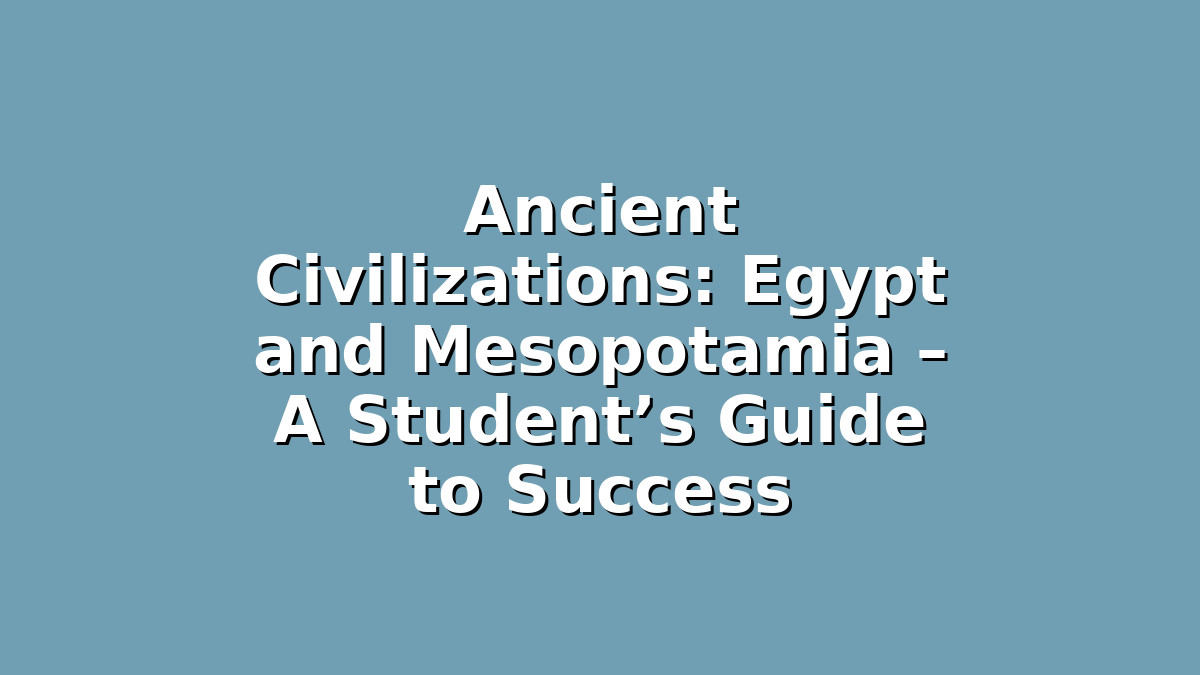Preparing for exams can be challenging, especially when it comes to understanding ancient civilizations like Egypt and Mesopotamia. These two cradles of human history offer fascinating stories, complex societies, and important innovations that shaped the modern world. As a student, mastering their history not only helps you ace your exams but also gives you a deeper appreciation of how our past influences the present. This article will guide you through the key features of these civilizations and provide practical study tips to help you retain the information effectively.
Introduction to Ancient Civilizations: Egypt and Mesopotamia
Ancient Egypt and Mesopotamia are often called the “Cradles of Civilization” because they represent some of the earliest complex societies in human history. Both arose around fertile river valleys—the Nile in Egypt and the Tigris-Euphrates in Mesopotamia—providing resources that supported agriculture, urban development, and culture. Understanding their geography, culture, political systems, achievements, and legacies is essential for history students. But memorizing facts is not enough; you need to adopt effective strategies to study and recall this information confidently.
—
1. Understanding Geography and Its Influence: Focus on River Valleys
To start, get familiar with the geography of Egypt and Mesopotamia because it played a crucial role in their development.
– Ancient Egypt thrived along the Nile River. The Nile’s predictable flooding enriched the soil, allowing Egyptians to grow crops like wheat and barley. This stability supported a centralized government and monumental architecture such as pyramids.
– Mesopotamia, located between the Tigris and Euphrates Rivers (modern-day Iraq), experienced less predictable flooding. Early Mesopotamians developed irrigation systems to control water flow, leading to the rise of city-states like Ur and Babylon.
Study Tip:
Create a comparative chart that highlights the geographical features and how they influenced each civilization’s economy, culture, and government. Visual aids like maps or diagrams can help you remember these facts better. For example, sketch the Nile’s path and label key features like the delta and cataracts, then do the same for the Tigris and Euphrates. This active engagement with the material helps solidify your understanding.
—
2. Exploring Social Structure and Governance: Who Ruled and How?
Next, focus on the social and political organization of these civilizations. Understanding the roles people played makes it easier to recall historical facts.
– In Egypt, Pharaohs were considered gods on earth, wielding absolute power. The society was highly stratified with priests, nobles, scribes, craftsmen, and farmers. Religion was deeply intertwined with governance, and the belief in the afterlife led to elaborate burial practices.
– Mesopotamia consisted of multiple city-states, each governed by a king or ruler, often seen as appointed by the gods but not divine themselves. The famous Code of Hammurabi introduced one of the first legal systems, emphasizing justice and order.
Study Tip:
Try to build storylines around these roles. For example, imagine you are a scribe in Mesopotamia recording laws or a priest in Egypt explaining the Pharaoh’s divine role. Creating characters or narratives can make abstract information tangible and memorable. Use flashcards to quiz yourself on social classes and their functions, or write short summaries from each perspective.
—
3. Remembering Key Achievements: Innovations and Legacies
Both civilizations contributed enormously to human progress. Highlighting their achievements can boost your confidence and make your answers stand out in exams.
– Egypt’s achievements include the development of hieroglyphic writing, advances in medicine, engineering feats like the pyramids, and contributions to art and architecture.
– Mesopotamia is credited with inventing cuneiform script, the wheel, plow, and early astronomy and mathematics.
Study Tip:
Use mnemonic devices to remember lists of inventions or accomplishments. For instance, for Mesopotamian inventions, you might create a phrase where each word starts with W (Wheel), C (Cuneiform), P (Plow), A (Astronomy), and M (Mathematics). Also, try teaching these achievements to a friend or family member—explaining concepts out loud enhances understanding and retention.
—
Conclusion: Your Path to Exam Success
Studying ancient Egypt and Mesopotamia doesn’t have to be overwhelming. By focusing on geographical context, social and political structures, and key achievements—and applying the study strategies outlined above—you can approach your exams with confidence. Remember, repetition and active engagement are your best allies. Use visuals, storytelling, flashcards, and mnemonic devices to make the information stick.
Above all, stay positive. Ancient civilizations might seem distant in time, but their stories are pieces of a puzzle that helped build the world we live in today. Embrace the learning process, and your hard work will pay off when you see your exam results. Good luck!
—

Responses